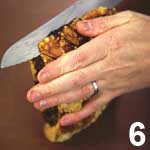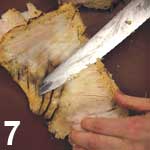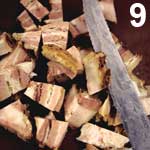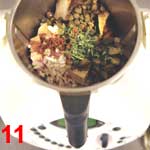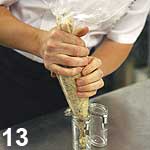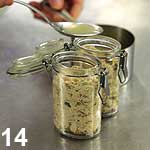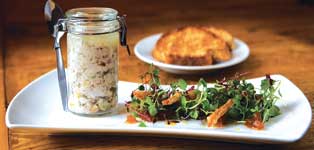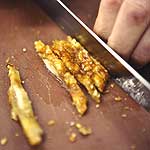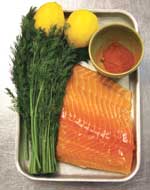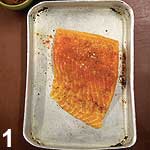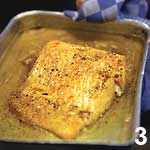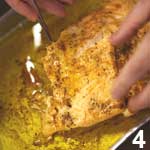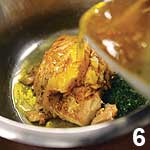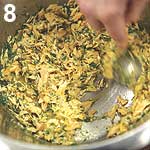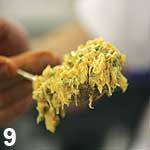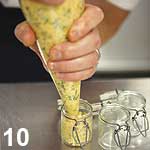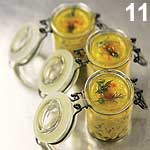Masterclass – potting meat and fish with James Mackenzie
The great British art of potting meat and fish seems to have been largely forgotten by today's chefs. Not so in the East Riding of Yorkshire, though, where James Mackenzie has made potted dishes a big feature of his menu. Michael Raffael reports
Well-made potted foods are national dishes of which we should be justly proud." (Michael Smith, Fine English Cookery)
There was a moment, a generation ago, when potted meats and fish could have made a comeback. Modern British cooking had repulsed Nouvelle Cuisine. Chefs and their customers were reacting against silly combinations allied to mini-portions. Critics dusted down words like "robust" and "gutsy" to describe dishes they enjoyed.
So why didn't it happen then? Partly it was Jamie and the Italian connection. Partly, it was Heston and his little grey molecules. Partly it was sous-vide, water baths and other new kit. Chefs were too busy sourcing new producers or creating dishes to look back in time.
If they had, they would have found a lost branch of our own repertoire: potting. At the basic level potted meat recipes are kissing cousins of rillettes. Flick through old cookery books and you'll find ways of potting every kind of protein, from kippers to cheese and from rabbit to goose.
They tend to be more or less rich, either from rendered fat or butter. They have more varied seasonings than would be common in France or Italy. Mace is the most common one, but cayenne, ginger, nutmeg and pepper are popular, too. Semi-preserves, they were made to be store foods. In the past, they were often concocted from left-overs.
At the Pipe and Glass, South Dalton, James Mackenzie has potted grouse, partridge, pork, salmon, crab and shrimps. Preparing them simply, he packs them with flavour. He designs them for customers with appetites, but presents them in ways that reflect a contemporary style. He isn't just borrowing from the past. His recipes have a distinctive personal touch.
JAMES MACKENZIE
The Pipe and Glass's recent Michelin star seems almost an irrelevance. The pub that James Mackenzie and wife, Kate, run at South Dalton near Beverley in the East Riding, is so well integrated in the local community it doesn't need accolades.
However, it does deserve them. The clear menu, carefully structured prices and unaffected service hide the serious aspirations that the couple harbour. In four years they have built up the Pipe and Glass to a business employing 30 staff. They opened two bedrooms, "Sage" and "Thyme" just before Christmas and are self-publishing a book. Coming here was a natural progression for James, who spent his formative years as a chef with Andrew Pern at the Star Inn. His cooking reflects his surrounding and his interest in traditional Yorkshire food.
Jay Rayner, in a recent Observer review, wrote: "I hope very much that the awarding of the star brings it serious custom. What I hope it doesn't bring is battalions of fork-wielding, napkin-sniffing, dish-photographing Michelin pervs". He needn't worry. Although the prize is bringing the rewards that are in its gift, the Mackenzies have done well enough without it.
All the pictures used below were taken by Lisa Barber
POTTED PORK
Choice of meat Belly or shoulder of pork both work, provided that the lean and fat balance. This will vary according to taste or individual cuts. Aim for about 30 percent fat content or more in the finished recipe.
Intensively farmed pork will be too lean, too dry and either stringy or pasty. It will also shrink more after prolonged roasting.
Yield
This depends on the cut of meat, whether the joint is bone-in or not, the amount of crackling and shrinkage during roasting. Plan for a 50 percent of raw weight yield.
Roasting
- 1.5kg pork belly in a piece
- 50ml unrefined rapeseed oil (or a neutral oil)
- 15g sea salt
Stand a rack over a roasting tin or tray (1). Pour in about one litre of water (2). Preheat a convection or combination oven to 180°C.
Rub the oil over the meat and rind (3). Rub with salt (4). Stand the joint on the rack and roast for three to three-and-a-half hours. Add water to the tray if it evaporates.
The crackling should be crisp and the meat cooked through (5). The texture of the fibres when cooled will be similar to rillettes.
Cool or chill the meat. Pare away the crackling in one or two pieces and reserve it (6). Keep any fat from under the rind with the rest of the meat (7).
POTTED PORK
Quantity 1.2kg approx
Serves 10-12
Equipment either individual 100ml container jars, pots or a lidded storage container
INGREDIENTS
- 800g roasted pork
- 100g diced shallots
- 100g cornichons in vinegar, sliced
- 100g capers in vinegar
- 10 finely shredded sage leaves
- 300g melted goose fat
- 20g salt
- 1tsp cracked pepper
1tsp powdered mace
METHOD
Cut the meat and any reserved fat into large (5cm) cubes (8 and 9). Combine with the shallots, cornichons, capers, half the sage, 70g goose fat, salt pepper and half the mace (10).
Blend in the Thermomix or Robot Coupe for less than 10 seconds (11). The meat should retain some texture (12). Test for seasoning.
Depending on the type and size of food processor, you may have to do this in two batches.
Fill a piping bag with the mixture. Pipe into the jars without completely filling them (13). Top up the jars with the remaining melted goose fat (14). Sprinkle shredded sage and a fine dusting of mace on top and leave to set (15).
SERVING
The potted pork will store in the fridge for at least a fortnight. Before service, remove portions from the fridge into an ambient setting so that the texture will be soft and spreadable when served to the customer.
Pipe and Glass potted Gloucester Old Spot pork with sticky apple and crackling
INGREDIENTS (Serves one)
- 1 pot of potted pork
- 30g sticky apple (see below)
- 2 heaped tbs dressed micro-salads (see below)
- 4-5 strips of freshly crisped crackling
- To accompany: 2 slices toasted spelt bread
On the plate, arrange the pot to one side (at the Pipe and Glass a teaspoon is slotted into the Kilner jar lid). Make small piles of sticky apple on the plate. Cover with the micro salad. Lay strips of crackling on top and accompany with toast.
WINE SUGGESTIONS
Red Sumaridge, Pinot Noir, Hemel-en- Aarde Valley, South Africa 2004, Dark, bramble flavours, smooth tannins, velvety finish.
White Monchof Mosel Spätlese 2007 Pear-gold, citrus notes, medium sweet with a long finish.
STICKY APPLES
Make a caramel with 250g sugar. Add a litre of apple juice. Boil and reduce to a tacky syrup. Peel, core and chopped the apples in cubes, about a centimetre each. Add them to the syrup and reduce a little more so that they are just cooked and sticky. Leave to steep in the syrup.
DRESSING FOR MICROSALADS
- 1tbs grain mustard
- 150ml white wine vinegar
- 500ml unrefined rapeseed oil
- Salt and pepper
Note: Unrefined rapeseed oil may come from different sources. Its flavour and texture can vary considerably. Choose a "nutty" variety rather than a "fishy" one. Use about a teaspoon per portion of micro-salads.
POTTED SALMON
INGREDIENTS
- 350g-400g trimmed and pin-boned salmon in a piece
- Black pepper
- Paprika or Pimenton
- Powdered mace
- 1-2tsp sea salt
- 200g clarified butter
- Grated zests of 1-2 lemons
- Lemon juice to taste
- 4tbs chopped fresh dill
- Preheat the oven to 190°C
METHOD
Season the salmon on the rounded side with pepper, paprika, mace and salt ((1). Place it in a tray of similar size. Pour the clarified butter around it so that it almost covers the fillet (2). Bake in the oven until just cooked (3). This takes about 10 minutes. Baste the fish half way through. The fish is ready when the flakes pull apart without traces of rawness (4).
Put the lemon zests, juice and dill in a large bowl. Add the hot fish (5) and about half the butter ((6). Keep forking the mixture (7) until the salmon breaks up and the butter starts to cream around the fibres (8). Test the seasoning (9).
Pipe the salmon into pots (10). Cover the tops with the rest of the butter used for cooking the salmon. Decorate with dill and paprika. Leave to set (11).
Note: At the Pipe and Glass small (about 30g) jars of potted salmon are served as one of a trio of salmon starters.
POTTED MEAT AND FISH
Potted char In Victorian England this was a favourite, made with a fish that is found only in the Lake District. The china pots from which it was served, hand-painted with pictures of swimming char, show up from time to time in antique shops. In the 1970s, Rothay Manor, on Lake Windermere served it during the autumn when it came into season.
Potted shrimps Still a speciality of Morecambe Bay, the small, brown shrimps are picked and coated in butter, flavoured with mace and Cayenne.
Potted cheese Not just an excuse for using left-over "mouse-trap", grated cheese (Cheshire was preferred) was mashed with butter or cream and sherry, spiked with cayenne pepper.
Potted grouse The Pipe and Glass still makes this, using the large or damaged birds that aren't suitable for presenting to customers.
Potted crab After the Second World War, during the years of food rationing, a cheap fish paste was sold as potted crab. This bore little resemblance to the classic recipe that combines white and dark meat.
Potted beef Food writer Sophie Grigson has a recipe for potted beef. She slow-cooks the meat flavoured with anchovy and nutmeg overnight and blends it with butter.
Potted rabbit The 20th-century chef-writer Michael Smith made this by stewing rabbit, pork and chicken livers in cider and seasoning the mixture with ginger and rum. He accompanied it with crab apple jelly.
Photography by Lisa Barber (www.lisabarber.co.uk)








